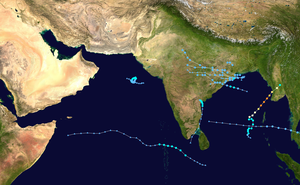
Back Temporada de ciclones no Índico Norte de 2006 Portuguese 2006 North Indian Ocean cyclone season SIMPLE 2006年北印度洋氣旋季 Chinese
| 2006 North Indian Ocean cyclone season | |
|---|---|
 Season summary map | |
| Seasonal boundaries | |
| First system formed | January 13, 2006 |
| Last system dissipated | October 30, 2006 (Officially) December 7, 2006 (Unofficially) |
| Strongest storm | |
| Name | Mala |
| • Maximum winds | 185 km/h (115 mph) (3-minute sustained) |
| • Lowest pressure | 954 hPa (mbar) |
| Seasonal statistics | |
| Depressions | 12, 1 unofficial |
| Deep depressions | 6, 1 unofficial |
| Cyclonic storms | 3 |
| Severe cyclonic storms | 2 |
| Very severe cyclonic storms | 1 |
| Extremely severe cyclonic storms | 1 |
| Total fatalities | 623 total |
| Total damage | At least $6.7 million (2006 USD) |
| Related articles | |
The 2006 North Indian Ocean cyclone season had no bounds, but cyclones tend to form between April and December, with peaks in May and November. These dates conventionally delimit the period of each year when most tropical cyclones form in the northern Indian Ocean.
The scope of this basin is north of the Equator and west of the Malay Peninsula. The IMD and JTWC monitor this basin. This basin is divided in two seas by India, the Bay of Bengal and Arabian Sea, abbreviated BOB and ARB, respectively.
Although an inactive year, 2006 had more of note than previous years like 2005 or 2004. Cyclone Mala caused severe damage and killed 22 when it hit Burma as a cat. 3. An unnamed depression killed over 100 in India, and cyclonic storm Ogni caused minor effects in India as well. Additionally, the remnants of Typhoon Durian crossed the Malay Peninsula causing minor effects, but was a rare basin-crosser in this area.